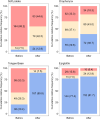The role of positional changes in optimizing OSA treatment: evidence from DISE
- PMID: 40064683
- PMCID: PMC12055893
- DOI: 10.1007/s00405-025-09314-y
The role of positional changes in optimizing OSA treatment: evidence from DISE
Abstract
Purpose: This study aimed to assess the impact of positional changes on upper airway obstruction patterns during drug-induced sleep endoscopy (DISE) in patients with obstructive sleep apnea (OSA) and identify the airway regions most responsive to this change. Special focus was placed on the tongue base, a critical area in OSA pathophysiology.
Methods: This prospective study was conducted from June 2021 to June 2024. DISE was performed in patients with obstructive sleep apnea (OSA) in supine and lateral positions to simulate the effect of positional therapy. Findings were evaluated using the VOTE classification.
Results: The examination was performed on 186 patients, with a median Apnea-Hypopnea Index (AHI) of 19.3. In the supine position, complete obstructions were noted at the soft palate (88.2%), oropharynx (33.3%), tongue base (53.2%), and epiglottis (15.6%). Lateral positioning significantly reduced obstructions, particularly at the tongue base, where obstruction resolved in 94/99 of cases (94.9%). This improvement was significantly more pronounced at the tongue base than at other sites (p < 0.001).
Conclusion: These results suggest that DISE can identify airway regions responsive to positional changes, potentially guiding clinical decisions on positional therapy. The findings show a significant reduction in tongue base obstruction during lateral positioning in DISE. Since tongue base obstruction is a key contributor to airway collapse in OSA, this improvement suggests a practical, non-invasive treatment approach. While these findings highlight an acute association between lateral positioning and reduced obstruction, further studies are needed to evaluate its long-term clinical efficacy.
Keywords: Drug-induced sleep endoscopy; Obstructive sleep apnea; Positional therapy; Tongue base obstruction.
© 2025. The Author(s).
Conflict of interest statement
Declarations. Conflict of interest: Mladoňová Michaela, Fedorová Katarína, Jor Ondřej, Slonková Jana, Kondé Adéla, Komínek Pavel and Matoušek Petr declare that they have no conflict of interest. Ethical approval: The study was approved by by the Ethics Committee of the University Hospital Ostrava (identifier: 360/2021) and the study was performed in accordance with the ethical standards as laid down in the 1964 Declaration of Helsinki and its later amendments or comparable ethical standards. Informed consent was obtained from all patients for being included in the study.
Figures



Comment in
-
Evaluation of positional variations through DISE in optimizing the treatment of OSA.Eur Arch Otorhinolaryngol. 2025 Aug;282(8):4387-4388. doi: 10.1007/s00405-025-09359-z. Epub 2025 Apr 7. Eur Arch Otorhinolaryngol. 2025. PMID: 40195195 No abstract available.
References
-
- Lai YJ, Li CY, Hung CH, Lin CY (2024) Severity of tongue base collapse in various body positions in patients with obstructive sleep apnea: a trajectory analysis. J Formos Med Assoc 123(11):1175–1181. 10.1016/j.jfma.2024.01.033 - PubMed
-
- Torre C, Liu SY, Kushida CA, Nekhendzy V, Huon LK, Capasso R (2017) Impact of continuous positive airway pressure in patients with obstructive sleep apnea during drug-induced sleep endoscopy. Clin Otolaryngol 42(6):1218–1223. 10.1111/coa.12851 - PubMed
-
- de Vries GE, Hoekema A, Claessen JQPJ, Stellingsma C, Stegenga B, Kerstjens HAM, Wijkstra PJ (2019) Long-term objective adherence to mandibular advancement device therapy versus continuous positive airway pressure in patients with moderate obstructive sleep apnea. J Clin Sleep Med 15(11):1655–1663. 10.5664/jcsm.8034 - PMC - PubMed
MeSH terms
Grants and funding
LinkOut - more resources
Full Text Sources
Medical

